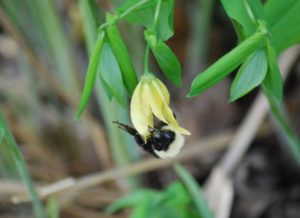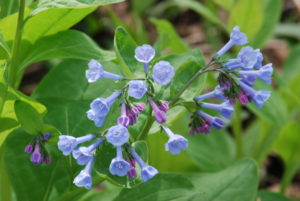By Larry Cornelis – Sydenham Field Naturalists
There is a spring time delight in the woods.
It is pretty, delicate and fleeting.
It is a beautiful carpet of diminutive but showy and colourful flowers that is sometimes accompanied by snowflakes.

These are the spring ephemerals of the deciduous woods.
The first wildflowers to bloom every year.
‘Ephemeral’; short-lived, transitory, lasting a day, does describe these wildflowers to some degree but these are strong perennial plants that are actually long-lived returning to bloom for decades.
They are fleeting in flower and leaf because they have to take advantage of the short period of time in our deciduous woods when the sunlight reaches the ground for them to grow.
Once the woodland trees are fully leafed out, then the light levels are too low to support most plant growth.
So, they spend most of the year dormant, lying in wait for the next winter to succeed into a new spring.
Then develop new growth and bloom again.
They have specially developed root systems to be able to do this.
To survive, in some cases for several months without leaves to photosynthesize food, they depend on the storage of sugars, carbohydrates and nutrients in these root systems which include corms, fleshy roots and bulbs.
Just another example of the wonders of nature.
You probably know some of these woodland wildflowers by name such as Trilliums but there are numerous species including Bellwort, Bloodroot, Dutchman’s Breeches, Green Dragon, Harbinger of Spring, Hepatica, Jack-in-the-Pulpit, Mayapple, Spring Beauty, Toothwort, Trout Lily, Twinleaf, Virginia Bluebells and Wild Geraniums to name a few.
The first to bloom in our local woods is the Harbinger of Spring.
A very delicate plant with clusters of tiny white flowers that grows to only a few inches tall.
Spring wildflowers come in all colours, white, pink, blue, mauve, red and yellow.
There are white and red Trilliums, the white turning to pink as the flower petals age.

Virginia Bluebells display an enchanting sky blue around the Mother’s Day weekend each spring.
Come back in summer and you would never know they were there.
Other spring ephemerals, such as Bellwort, Trilliums and Geraniums do have leaves through most of the growing season.
Most spring ephemerals have a special way to disperse their seeds.
Some have seed pods that twist as they dry and then snap springing loose the seeds, ejecting them up to a metre away.
Many have a special treat for ants coating the seed.
This is called the ‘eliaosome’, a fatty, lipid-rich appendage on the seed.
The ants gather the seeds and take them back to their colony to feed the eliaosome to their young.
When the food is gone, they carry the seeds out of the colony and disperse them in the woods, but not too far from the colony.
Woodland wildflowers are very slow to spread.
Once spring ephemerals are lost from the forest it is rare that they can return.
Logging practices and cattle grazing can permanently erase them from the woods.
They should be cherished and protected.
We should protect our remaining woodlands and never consider a row tree plantation as compensation for clear cutting woodlands.
The spring ephemerals will never return to a plantation.
They are part of the interconnected web of life in the forest ecosystem.
Bumble bee queens find their first source of nectar from woodland wildflowers and song birds thrive on the fruits and seeds.
Bloodroot is already blooming in my front yard.
It was blooming on March 25, the earliest I’ve seen it bloom.
Now is the time to go for a walk in the woods to experience and enjoy this spring time delight.
Visit the Reid Conservation Area or the trails at the Darcy McKeough Dam or Clear Creek Forest.
Nature is our respite from these challenging times.
For more details, visit: http://www.sydenhamfieldnaturalists.ca/
















